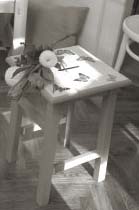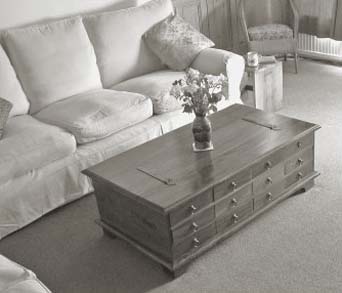3.3 Forming concepts
When we think about the world one of the ways that we organise our thoughts is by putting them into categories. This process of developing categories is called concept formation. For example ‘animal’ is a concept that contains other sub-concepts and then further sub-concepts. We could divide animals into birds, fish, mammals, etc. We could then divide birds into robins, sparrows, owls, etc. When we apply our concepts we tend to use a set of defining features. For example we would classify the sparrow as a bird because it has a number of defining features that we associate with birds such as wings, feathers, beaks and flying. However although we may have a set of defining features for a concept such as a bird we don't apply these rigidly. Penguins and ostriches are still classified as birds even though they don't fly.
Activity 5: Defining a simple concept
What makes a table a table? We all have a concept of what a table is and can easily recognise a table whether it is a dining table, garden table or coffee table. Can you take a moment to write a list of the defining features of a table?
Discussion
Most people when asked this relatively simple question will tell you that a table has a flat surface, four legs to raise it off the ground and you can put things on it. They may add other features such as it is an item of furniture or it is often but not always made of wood, but the first three features are the most frequent responses.
However look at the picture below.
This table doesn't have four legs but most of us would still recognise it as a table as it has a flat surface that we can put things on.
Similarly our definition of a table as a piece of furniture with a flat surface with four legs could just as easily be applied to a stool.

So while we would find it difficult to specify a way of distinguishing between a small occasional table and a stool we would not walk into someone's living room and sit on their occasional table because it shares the same the features as a stool. So our concepts are not clearly defined and seem to depend on what we expect to do with an object rather than how we define them. You may have heard the phrase ‘fuzzy concept’ which reflects our difficulty in providing precise definitions.
So we recognise the object in Figure 7 above as a table because we could use them to put things on such as a book, our drink or an ornament. The object in Figure 8 is a stool because we would sit on it. We will group objects within the same category or concept if we do the same thing with them.
We use concepts so automatically that we are rarely aware that we are using them. Perhaps it is easier to see this process in action when we observe children developing their thinking as they struggle to develop concepts. Children often make mistakes by overgeneralising a concept that they are trying to get to grips with. They may have developed a concept for a dog as an animal with hair, four legs and a tail, but then they may also apply this label to a cat or a sheep or even a horse. Similarly they may learn that the tall person with the deep voice is called Daddy and then may embarrassingly identify any passing man as Daddy.
It may also become evident how much we use concepts when we look at a few memory experiments. Try the first experiment for yourself in the activity below.
Activity 6: A memory test
Read once through the list of words below trying to remember them and then scroll the screen until the list disappears but you can still see the ‘Reveal discussion’ link. Once you have written down as many words as you can remember click to read the discussion.
Bed
Peach
Hat
Armchair
Daffodil
Shirt
Rose
Lemon
Sock
Daisy
Strawberry
Table
Buttercup
Apple
Sideboard
Trousers
Discussion
Now that you have written all the words down that you can recall, I would like you to see if you can remember any more words with the help of some cues. The list contains items belonging to the following categories; furniture, fruit, clothing and flowers. Have the cues helped you remember any more words?
Have a look at your first try at recalling the words. Did you realise that the words belonged to categories and did you recall them in category clusters?
If possible you could try this out on some other people and compare their results with yours.
This experiment is a simplified version of an experiment by Weston Bousfield (1953). Bousfield asked participants to learn a list of 60 words that could be divided into four categories. Though the words were presented in a random order, the participants tended to remember them in groups which belonged to the same category, so if they remembered apple, then they would remember peach, lemon and strawberry.
In our version of the experiment you were also asked to have a second go at recalling the words after you had been given the category headings. Most participants in these types of experiments find that although they think they have recalled all the words they will be able to remember, they can actually access more words once they have been given category headings as cues.
This illustrates that this information must have been available but without the cue they could not access it. When we try to recall information that has been organised it seems each bit of the information cues the next bit because we have it stored in an organised rather than haphazard fashion.
Some research from George Mandler (1967) suggests that by organising information we learn it even though we are not making any effort to memorise it. Mandler carried out an experiment where two groups of participants were given a pack of 100 cards each. Each card had a word printed on it. Both groups of participants were told to sort the cards into groups. They were allowed to have several tries at sorting the cards. The only difference between the two groups of participants was that the first group were told to try and memorise the words on the cards while they were sorting them but the other group were only told to sort the cards. When both groups were later tested by being asked to write down all the words they could remember the group who were only told to sort the words remembered as many words as the group who were told to sort and memorise the words.
Activity 7: Identifying variables again
In the Mandler experiment can you identify the following variables?
the independent variable
the dependent variable
Discussion
The independent variable is the variable that the experimenter manipulates so this is the instruction to try and memorise the words which was given to one group only.
The dependent variable is the number of words recalled.
You may rightly argue that being able to remember lists of words in category groups is not a particularly useful skill for everyday life. However the principle of organising information so that it is grouped with related items can be applied to activities like reading this course. You may be aware of mind mapping, which is simply a way of organising information so you can see which items go together and how they are related to other items.
Skim reading is a good way to get an overall idea of what is going to be covered in the material you are looking at. The titles, subtitles, bullet point lists and diagrams can help you see how the material has been organised. Keeping this organisation in mind can be a useful aid to study. You can start out with a rough sketch of how the material is organised and then add to it or amend it as you do your close reading.
We'll now look at a third way of organising our thoughts which is very similar to concept formation but is more extensive, and that is using schemas.

